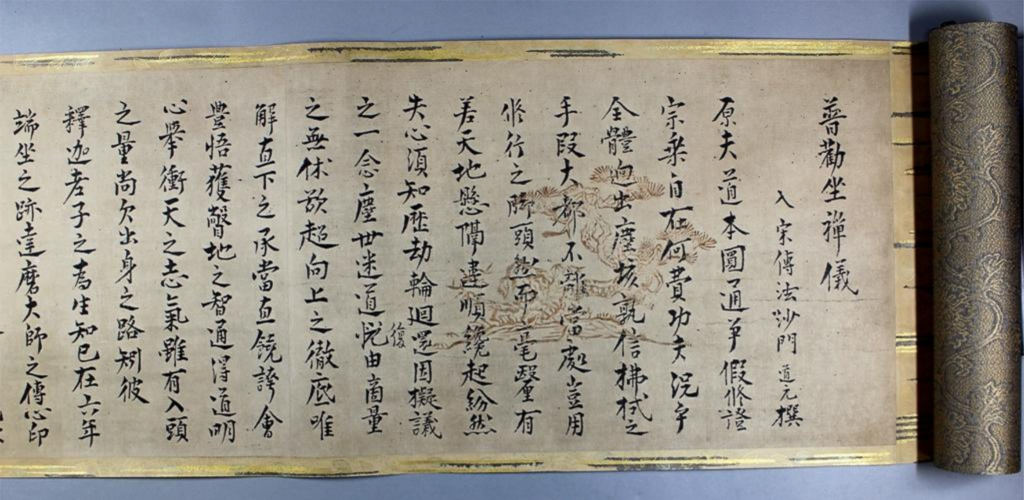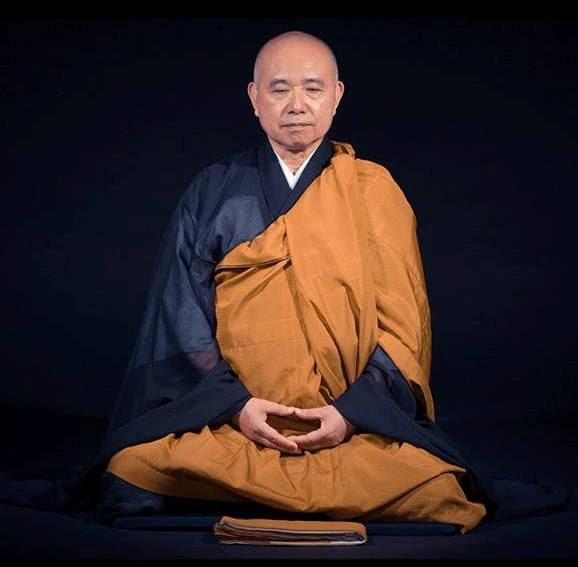Upon returning from China in 1227, Dogen had gone back to the Kenninji monastery. A few months later that year, he wrote the Fukan Zazengi (Universal Recommendations for Zazen), which, Hee-Jin Kim tells us, “might have been regarded as the manifesto of Dogen’s “new” Buddhism vis-à-vis the established Buddhism of Japan.” It is a short text – about two pages – originally written in classical Chinese, where Dogen presents what he understood to be the very essence of his teachings – the practice of a particular type of zazen he calls “shikantaza” (“just sitting”). The text was reworked several times during the following years, so several versions exist. The Terebess website offers six versions/translations side by side for easy comparison. I will use primarily the text called Rufo-bon (popular version), a translation of the last version of the text (1244) by Shohaku Okumura. Although shikantaza is in principle the form of zazen the Chinese Caodong (Soto) school called “Silent Illumination,” it is thought that Dogen made some fine adjustments based on his own experience.

The text starts with Dogen’s reaffirmation of the doctrine of original enlightenment: “Originally, the Way is complete and universal. How can we distinguish practice from enlightenment? The vehicle of Reality is in the Self. Indeed, the whole body is free from dust; who could believe in a means to brush it clean?” The last sentence appears to echo Huineng’s verses: “The mind is the bodhi tree; the body is the mirror’s stand; the mirror itself is so clean; dust has no place to land.” Zazen practice should not be seen as a means to purify one’s mind in order to attain enlightenment. It is instead the “expression” of our inherently enlightened nature, in Dogen’s words, “The vehicle of Reality (also translated as the Dharma-vehicle) is in the Self.” It is our Buddha-nature. And it is available to us right here, right now. “It is never apart from this very place.” So, “what is the use of travelling around to practice?”
Many of us have already gained a fair amount of understanding derived from our inherently enlightened nature. But, Dogen says, “You are playing in the entrance way, but you are still short of the vital path of emancipation.” Original enlightenment still needs to be “enacted” in our lives, and this is the function of zazen. “Consider Shakyamuni at Jetavana; although he was wise at birth, the traces of his six years of upright sitting can still be seen. As for [Bodhidharma at] Shorin-ji, although he transmitted the mind-seal, his nine years of facing a wall is celebrated still. If even the ancient sages were like this, how can we today dispense with wholehearted practice?”
If instead of using your consciousness to investigate the outside world with “words” and “phrases,” you “take the backward step that turns the light and shines it inward,” Dogen assures you that “body and mind of themselves will drop away, and your original face will manifest. If you wish to attain suchness, practice suchness immediately.” In other words, the very practice of shikantaza turns us into a buddha. Shikantaza is a practice in the double sense of the word “practice” as it is used, for instance, in the legal or medical spheres. One who practices law is not primarily a law student, (s)he is a lawyer who applies law, i.e., “carries out” its function in the world. This is in that sense that Dogen can talk of “practice-realisation.” Sitting in zazen is already being a buddha, for the length of the sitting.
Dogen then goes into the practical details of shikantaza: “For practicing Zen, a quiet room is suitable. Eat and drink moderately. Put aside all involvements and suspend all affairs. Do not think in terms of good or bad. Do not judge true or false. Give up the operations of mind, intellect and consciousness; stop measuring with thoughts, ideas and views. Have no designs on becoming a buddha. How could that be limited to sitting or lying down? At your sitting place, spread out a thick mat and put a cushion on it. Sit either in the full lotus or half lotus position … Always keep your eyes open, and breathe softly through your nose. Once you have adjusted your posture, take a breath and exhale fully, rock your body right and left, and settle into steady, immovable sitting.”
These sound like standard instructions for meditators. But Dogen continues: “Think of not thinking. How do you think of not thinking? Beyond-thinking. This is the essential art of zazen.The zazen I speak of is not meditation practice. It is simply the Dharma gate of peace and bliss, the totally culminated awakening.” What is meant here is that shikantaza is not a concentration practice on an object, or a counting of the breaths, as meditation had been in most schools of Buddhism. Shikantaza is “a thinking of not thinking,” which Okumura refers to as “beyond-thinking” in his translation, and “without thinking” in his book on Genjokoan. Other translations have used the word “non-thinking” instead, which in a Daoist context, means “spontaneous,” i.e., “unmediated thinking and feeling.” What this “beyond thinking” or “non-thinking” points to, is not a rejection of thinking as such. So it should not be taken to reflect an anti-intellectual stance. It concerns not the thoughts, but the “roots” of the thoughts, the soil out of which they emerge, and by which they are shaped. That “soil” is the ego-self active in ordinary everyday consciousness. The ego-self grabs the thoughts and uses them to strenghten its sense of solidity and existence. When thoughts arise out of “non-thinking,” they are “unmediated” by the ego-self, and therefore free from the egocentric standpoint. In shikantaza, the grabbing urge is dissolved. Thoughts naturally arise and are expressions of “suchness,” i.e., reality as it is, in itself and for itself. It is with a weakened urge to “grab” that one returns to ordinary everyday life at the end of the sitting (and even more so at the end of the intensive meditation retreats Zen calls “sesshins”). In time, our skill at living most of our lives from the standpoint of suchness grows, though there is never an end-point as enlightenment is an activity or process rather than a state we attain once and for all.
Okumura explains that “in Japanese the expression shikan means ‘just do it’, without the thought ‘I don’t like samsara so I’m practicing to reach nirvana in the future.’ Such goal-oriented thinking is just a story we create … We do nothing but sit with the whole body and mind.” He points out that it is actually a very “unique practice,” unlike any other in the Buddhist tradition …We just are as we are, that’s all … we simply sit without doing anything.”
“Just as the function of a thyroid gland is to secrete hormones, the function of a brain is to secrete thoughts, so thoughts well up in the mind moment by moment. Yet our practice in zazen is to refrain from doing anything with these thoughts; we just let everything come up freely and we let everything go freely. We don’t grasp anything; we don’t try to control anything. We just sit.” He adds that it is a “very simple practice,” but it is also a “very deep” practice, and not an “easy” one. In such a practice, “we let go of the individual karmic self,” that which constructs the narrative, and allow “the true self, the self that is one with the entire universe [to] ‘manifest’.” It is a practice of “letting go” that Uchiyama Kosho has referred to as “opening the hand of thought” in a book of the same name. As soon as one notices that a thought or a train of thoughts has arisen, one is to come back to either the posture or the breath. This is an exercise in “presencing of things as they are.”
Of course, as this involves dropping thoughts rather than threading them into meaningful theories, “intelligence or lack of it is not an issue;” there is “no distinction between the dull and sharp witted.” It is in this sense that Dogen’s zazen practice is accessible to all, irrespective of education, level of intelligence, or class.
Sources:
Hee-Jin Kim – Eihei Dogen Mystical Realist
Dogen – Fukan Zazengi – Rufo-bon (popular version) translated by Shohaku Okumura
Uchiyama Kosho – Opening the Hand of Thought
Shohaku Okumura – Realizing Genjokoan

